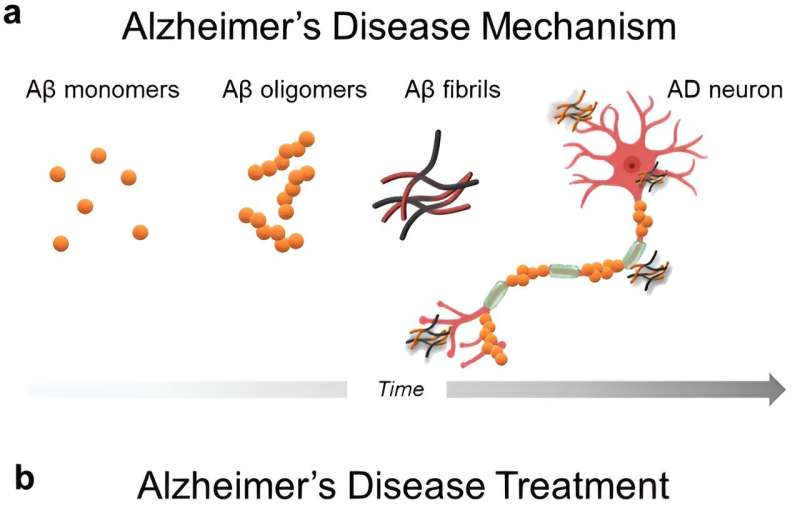This article has been reviewed according to Science X's editorial process and policies. Editors have highlighted the following attributes while ensuring the content's credibility:
fact-checked
peer-reviewed publication
trusted source
proofread
Nanoparticles activated by ultra-low-energy X-rays halt aggregation, toxicity of amyloid beta in preclinical models

A novel approach in the field of Alzheimer's research is emerging that could potentially transform how we tackle this debilitating disease. Recent studies have revealed a paradigm shift in understanding Alzheimer's pathology, emphasizing the importance of targeting the early-stage aggregation of the pathogenic amyloid beta (A-beta) protein, specifically focusing on its soluble oligomeric form.
Over the past three decades, conventional treatments for Alzheimer's have largely been ineffective, primarily due to their focus on combating the fibrillar form of A-beta. However, emerging research suggests that it is the soluble oligomeric form of A-beta that poses the greatest threat to neuronal health, leading to cognitive decline and neurotoxicity.
A recent breakthrough in Alzheimer's treatment has come from the development of an antibody capable of recognizing both oligomeric and fibrillar forms of A-beta, offering newfound hope to the field. This innovative therapy has demonstrated promising results in delaying disease progression by up to 36% in individuals with early-to-mild cognitive impairment.
Building upon this momentum, a collaborative effort between Israeli and Italian researchers has led to the development of a new treatment strategy targeting the early-stage aggregation of A-beta before the formation of toxic oligomers.
By harnessing the power of nanotechnology and ultra-low-energy X-rays, the researchers have successfully inhibited the aggregation and toxicity of A-beta in preclinical models, offering a potential avenue for early intervention in Alzheimer's disease. The work is published in the journal Advanced Healthcare Materials.
Prof. Shai Rahimipour, of Bar-Ilan University's Department of Chemistry, together with Italian scientists Profs. Angelo Monguzzi and Marcello Campione from the University of Milano-Bicocca, designed nanoparticles with high affinity to the early-stage soluble A-beta, which, when activated by ultra-low-energy X-rays, effectively halt the aggregation process. "This approach has shown promising results in neuronal cell cultures and animal models, offering new possibilities for early intervention in Alzheimer's disease," says Rahimipour.
The unique advantage of this approach lies in its potential to selectively target and irradiate the affected regions of the brain, minimizing the risk of side effects associated with traditional antibody-based therapies. Furthermore, preliminary studies have demonstrated the safety and efficacy of the nanoparticles and the low-energy X-rays in preclinical models, paving the way for further exploration in human clinical trials.
"Our ultimate goal is to develop a safe and effective treatment for individuals in the early stages of Alzheimer's, with a focus on those at high risk, such as those with familial Alzheimer's," states Rahimipour. "By targeting the early-stage aggregation of A-beta, we aim to prevent disease progression and improve the quality of life for patients and their families."
The research team holds a patent for the technology and the nanoparticles, which are composed of hydrated magnesium silicate, and has demonstrated blood-brain barrier permeability in animal models. Further research is underway to optimize the treatment regimen and assess its long-term efficacy in clinical settings.
More information: Sudipta Senapati et al, Noninvasive Treatment of Alzheimer's Disease with Scintillating Nanotubes, Advanced Healthcare Materials (2023). DOI: 10.1002/adhm.202301527



















